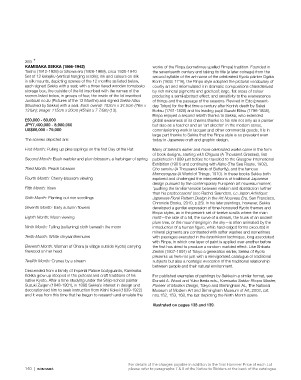Page 142 - Bonhams Fine Japanese Art London November 2018
P. 142
259 *
KAMISAKA SEKKA (1866-1942) works of the Rinpa (sometimes spelled Rimpa) tradition. Founded in
Taisho (1912-1926) or Showa era (1926-1989), circa 1920-1940 the seventeenth century and taking its title (a later coinage) from the
Set of 12 kakejiku (vertical hanging scrolls); ink and colours on silk second syllable of the art-name of the celebrated Kyoto painter Ogata
in silk mounts, depicting scenes of the 12 months as listed below, Korin (1658-1716), the Rinpa style adopted the pictorial vocabulary of
each signed Sekka with a seal; with a three-tiered wooden tomobako courtly art and reformulated it in dramatic compositions characterized
storage box, the outside of the lid inscribed with the names of the by rich mineral pigments and gold leaf; large, flat areas of colour
scenes listed below, in groups of four, the inside of the lid inscribed producing a semi-abstract effect; and sensitivity to the evanescence
Junitsuki no zu (Pictures of the 12 Months) and signed Sekka hitsu of things and the passage of the seasons. Revived in Edo (present-
(Brushed by Sekka) with a seal. Each overall: 193cm x 34.5cm (76in x day Tokyo) for the first time a century after Korin’s death by Sakai
13½in); image: 115cm x 20cm (45¼in x 7 7/8in) (13). Hoitsu (1761-1828) and his leading pupil Suzuki Kiitsu (1796-1858),
Rinpa enjoyed a second rebirth thanks to Sekka, who extended
£50,000 - 60,000 global awareness of its charms thanks to his role not only as a painter
JPY7,400,000 - 8,900,000 but also as a teacher and an ‘art director’ in the modern sense,
US$66,000 - 79,000 commissioning work in lacquer and other commercial goods; it is in
large part thanks to Sekka that the Rinpa style is so prevalent even
The scenes depicted are: today in Japanese craft and graphic design.
First Month: Pulling up pine saplings on the first Day of the Rat Many of Sekka’s earlier and more celebrated works came in the form
of book designs, starting with Chigusa (A Thousand Grasses), first
Second Month: Bush warbler and plum blossom, a harbinger of spring published in 1899 just before he travelled to the Glasgow International
Exhibition (1901) and continuing with Kairo (The Sea Route, 1902),
Third Month: Peach blossom Cho senshu (A Thousand Kinds of Butterfly), and the famous
Momoyogusa (A World of Things, 1910). In these books Sekka both
Fourth Month: Cherry-blossom viewing explored and challenged the interpretations of traditional Japanese
design pursued by the contemporary European art nouveau manner,
Fifth Month: Irises ‘pushing the familiar tension between realism and abstraction further
than his predecessors’ (see Rachel Saunders, Le Japon Artistique:
Sixth Month: Planting out rice seedlings Japanese Floral Pattern Design in the Art Nouveau Era, San Francisco,
Chronicle Books, 2010, p.23). In his later paintings, however, Sekka
Seventh Month: Early autumn flowers developed a gentler expression of time-honoured Kyoto themes and
Rinpa styles, as in the present set of twelve scrolls where the main
Eighth Month: Moon viewing motif—the side of a hill, the curve of a stream, the trunk of an ancient
plum tree, or the moon hanging in the sky—is often animated by the
Ninth Month: Fulling (softening) cloth beneath the moon introduction of a human figure, while hard-edged forms executed in
mineral pigments are contrasted with softer washes and sometimes
Tenth Month: White chrysanthemums with passages executed in the tarashikomi technique, long associated
with Rinpa, in which one layer of paint is applied over another before
Eleventh Month: Woman of Ohara (a village outside Kyoto) carrying the first has dried to produce a random marbled effect. Like Shibata
firewood on her head Zeshin (1807-1891) of Tokyo a generation earlier, Sekka of Kyoto
presents us here not just with a reinvigorated catalogue of traditional
Twelfth Month: Cranes by a stream subjects but also a nostalgic evocation of the traditional relationship
between people and their natural environment.
Descended from a family of Imperial Palace bodyguards, Kamisaka
Sekka grew up steeped in the pictorial and craft traditions of his For published examples of paintings by Sekka in a similar format, see
native Kyoto. After a time studying under the Shijo-school painter Donald A. Wood and Yuko Ikeda eds., Kamisaka Sekka: Rimpa Master,
Suzuki Zuigen (1848-1901), in 1890 Sekka’s interest in design and Pioneer of Modern Design, Tokyo and Birmingham AL, The National
decoration led him to seek instruction from Kishi Kokei (1839-1922) Museum of Modern Art and Birmingham Museum of Art, 2003, cat.
and it was from this time that he began to research and emulate the nos.152, 159, 168, the last depicting the Ninth Month scene.
Illustrated on pages 138 and 139.
For details of the charges payable in addition to the final Hammer Price of each Lot
140 | BONHAMS please refer to paragraphs 7 & 8 of the Notice to Bidders at the back of the catalogue.

